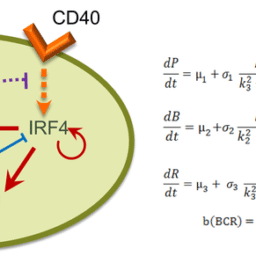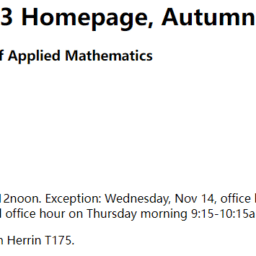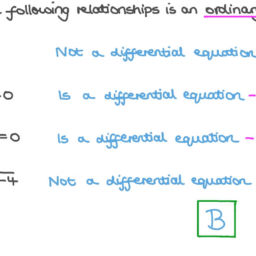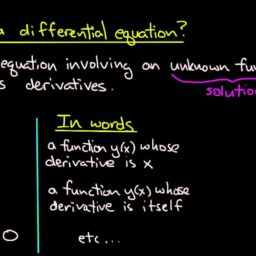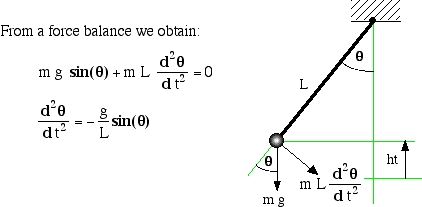MY-ASSIGNMENTEXPERT™可以为您提供stanford Math220 Ordinary Differential Equations常微分方程的代写代考和辅导服务!
这是斯坦福大学 常微分方程课程的代写成功案例。
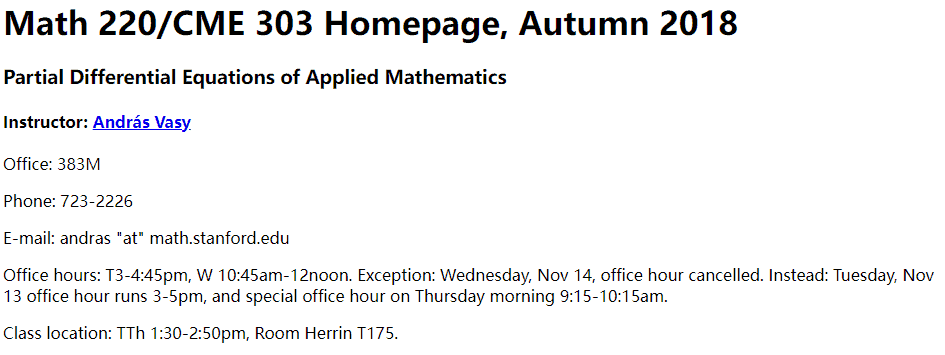
Math220课程简介
Grading policy: The grade will be based on the weekly homework (25%), on the in-class midterm exam (30%) and on the in-class (i.e. not take-home, to take place during finals week, as designated by the registrar) final exam (45%).
The homework will be due in class or in the instructor’s mailbox by 9am on the designated day, which will usually (but not always) be Fridays. You are allowed to discuss the homework with others in the class, but you must write up your homework solution by yourself. Thus, you should understand the solution, and be able to reproduce it yourself. This ensures that, apart from satisfying a requirement for this class, you can solve the similar problems that are likely to arise on the exams.
Prerequisites
Course Description : We will cover most of the textbook. This includes formulating physical systems as differential equations, learning various methods to solve them, basics of infinite series and how to use them to solve differential equations, studying linear and nonlinear systems of differential equations, and topological methods.
Learning Outcomes:: The broad learning goals of the course are:
Model various physical phenomena with differential equations
Understand that solutions to differential equations can be addressed with both exact methods and qualitative methods
Math220 Ordinary Differential Equations HELP(EXAM HELP, ONLINE TUTOR)
(1) Solve
$$
y u_x+x u_y=0, u(0, y)=e^{-y^2}
$$
(2) In which region is u uniquely determined?
Solution. This is a homogeneous linear PDE with no first order term, so its solutions are functions which are constant along the projected characteristic curves, i.e. the integral curves of the vector field $V(x, y)=(y, x)$. Note also that the initial curve, the $y$-axis, is characteristic at exactly one point, namely the origin, where $V$ vanishes. Elsewhere along the $y$ axis $V(0, y)=(y, 0)$ which is not tangent to the $y$-axis.
The characteristic equations in this case are
$$
\frac{d x}{d s}=y, \frac{d y}{d s}=x, \frac{d z}{d s}=0 .
$$
The $z$ ODE is trivial: $z=c_3(r)$. One can find the solution of the $(x, y)$ ODEs either by obtaining a second order ODE for $x$ :
$$
\frac{d^2 x}{d s^2}=\frac{d y}{d s}=x
$$
whose solutions are $x=c_1(r) e^s+c_2(r) e^{-s}$. As $y=\frac{d x}{d s}$, this gives
$$
(x, y, z)=\left(c_1(r) e^s+c_2(r) e^{-s}, c_1(r) e^s-c_2(r) e^{-s}, c_3(r)\right)
$$
Thus, $x+y=2 c_1(r) e^s, x-y=2 c_2(r) e^{-s}$, so $x^2-y^2=(x+y)(x-y)=4 c_1(r) c_2(r)$, i.e. is a constant along the projected characteristic curves. In other words, the projected characteristic curves are $x^2-y^2=C, C$ a constant, and the solution is a function that is constant along these. One has to be slightly careful, as the same value of $C$ corresponds to two characteristic curves, see the argument two paragraphs below concerning the sign of $r$. In particular, any function $f$ of $x^2-y^2$ will solve the PDE. As we want $f\left(x^2-y^2\right)=u(x, y)$ to satisfy $u(0, y)=e^{-y^2}$, we deduce that $f\left(-y^2\right)=e^{-y^2}$ for all real $y$, i.e. $f(t)=e^t$ for $t \leq 0$. Note that $f(t)$ is not defined by this restriction for $t>0$. So one obtains that $u(x, y)=f\left(x^2-y^2\right)$ solves the PDE where $f(t)=e^t$ for $t \leq 0, f(t)$ arbitrary for $t>0$.
In particular, the solution is not unique where $x^2-y^2>0$, i.e. where $|x|>|y|$. This is exactly the region in which the characteristic curves do not approach the $y$ axis.
To see how our usual method of substituting in the initial conditions works, note that the initial data curve is $\left(0, r, e^{-r^2}\right)$, so at $s=0$ we get $c_1(r)+c_2(r)=0$, $c_1(r)-c_2(r)=r, c_3(r)=e^{-r^2}$, so the solution of the characteristic ODEs taking into account the initial conditions is
$$
(x, y, z)=\left(\frac{r}{2}\left(e^s-e^{-s}\right), \frac{r}{2}\left(e^s+e^{-s}\right), e^{-r^2}\right)=\left(r \sinh s, r \cosh s, e^{-r^2}\right) .
$$
As $\cosh ^2 s-\sinh ^2 s=1$, we deduce that $y^2-x^2=r^2$ along the projected characteristic curves. This gives that $|y| \geq|x|$ in the region where the projected characteristic curves crossing the $y$ axis reach. In this region, $r= \pm \sqrt{y^2-x^2}$, with the the sign \pm agreeing with the sign of $y$ (i.e. is + where $y>0$ ). In any case, the solution is $u(x, y)=e^{-r^2}=e^{x^2-y^2}$ in $|y| \geq|x|$. Note that this method does not give the solution in the region $|y|<|x|$, as the projected characteristic curves never reach the region. Note also that there is no neighborhood of the origin in which this method gives $u$; this is because the $y$-axis is characteristic for this PDE at the origin.
A simpler way of finding the projected characteristic curves is to parameterize them by $x$ or $y$. In the former case, one gets
$$
\frac{d y}{d x}=\frac{\frac{d y}{d s}}{\frac{d x}{d s}}=\frac{x}{y},
$$
so $\int y d y=\int x d x$, i.e. $y^2=x^2+C$. Again, $C$ is a parameter.
(1) Solve $u_x+u_t=u^2, u(x, 0)=e^{-x^2}$.
(2) Show that there is $T>0$ such that $u$ blows up at time T, i.e. $u$ is continuously differentiable for $t \in[0, T), x$ arbitrary, but for some $x_0,\left|u\left(x_0, t\right)\right| \rightarrow$ $\infty$ as $t \rightarrow T-$. What is $T$ ?
Solution. The characteristic ODEs are
$$
\frac{d x}{d s}=1, \frac{d t}{d s}=1, \frac{d z}{d s}=z^2
$$
The solution is
$$
\begin{aligned}
& x(r, s)=s+c_1(r), \
& t(r, s)=s+c_2(r), \
& -z^{-1}=s+c_3(r) \Rightarrow z=\frac{-1}{s+c_3(r)} .
\end{aligned}
$$
The initial conditions give that at $s=0,(x, t, z)=\left(r, 0, e^{-r^2}\right)$, so $c_1(r)=r$, $c_2(r)=0, c_3(r)=-e^{r^2}$. Thus
$$
(x, t, z)=\left(s+r, s, \frac{-1}{s-e^{r^2}}\right) .
$$
Inverting the map $(r, s) \mapsto(x(r, s), t(r, s))$ yields $s=t, r=x-s=x-t$, so
$$
u(x, t)=z(r(x, t), s(x, t))=\frac{-1}{t-e^{(x-t)^2}} .
$$
Note that the denominator vanishes only if $t=e^{(x-t)^2}$, and $(x-t)^2 \geq 0$, so the denominator can only vanish if $t \geq 1$. In particular, $u$ is a $C^1$, indeed $C^{\infty}$, function on $\mathbb{R}_x \times[0,1)_t$. On the other hand, for $x=1$, as $t \rightarrow 1-, u(x, t)=\frac{-1}{t-e^{(1-t)^2}} \rightarrow+\infty$, i.e. the solution blows up at $T=1$ (at $\left.x_0=1\right)$.
Solve
$$
u_t+u u_x=0, u(x, 0)=-x^2
$$
for $|t|$ small.
Solution. We parameterize the $x$-axis as $\Gamma(r)=(r, 0)$, and note that the vector field $(z, 1)$ is not tangent to $\Gamma$ at any point regardless of the value of $z$, so this is a non-characteristic initial value problem. The characteristic equations are
$$
\begin{aligned}
& \frac{\partial t}{\partial s}=1, t(r, 0)=0 \
& \frac{\partial x}{\partial s}=z, x(r, 0)=r \
& \frac{\partial z}{\partial s}=0, z(r, 0)=-r^2
\end{aligned}
$$
The solution is
$$
\begin{aligned}
& t(r, s)=s, \
& z(r, s)=-r^2, \
& x(r, s)=-r^2 s+r .
\end{aligned}
$$
Thus, $s=t$, and $t r^2-r+x=0$, so if $t=0$ then $r=x$, and if $t \neq 0$ then $r$ solves
$$
r=\frac{1 \pm \sqrt{1-4 t x}}{2 t}
$$
The choice of the sign is dictated by $r=x$ when $t=0$ (i.e. by taking the limit as $t \rightarrow 0$ using, say, L’Hospital’s rule), so one needs the negative sign, and
$$
r=\frac{1-\sqrt{1-4 t x}}{2 t}
$$
The solution is then
$$
u(x, t)=-R(x, t)^2=-\frac{(1-\sqrt{1-4 t x})^2}{4 t^2}, t \neq 0,
$$
and $u(x, 0)=-x^2$.

MY-ASSIGNMENTEXPERT™可以为您提供UNIVERSITY OF ILLINOIS URBANA-CHAMPAIGN MATH2940 linear algebra线性代数课程的代写代考和辅导服务! 请认准MY-ASSIGNMENTEXPERT™. MY-ASSIGNMENTEXPERT™为您的留学生涯保驾护航。


